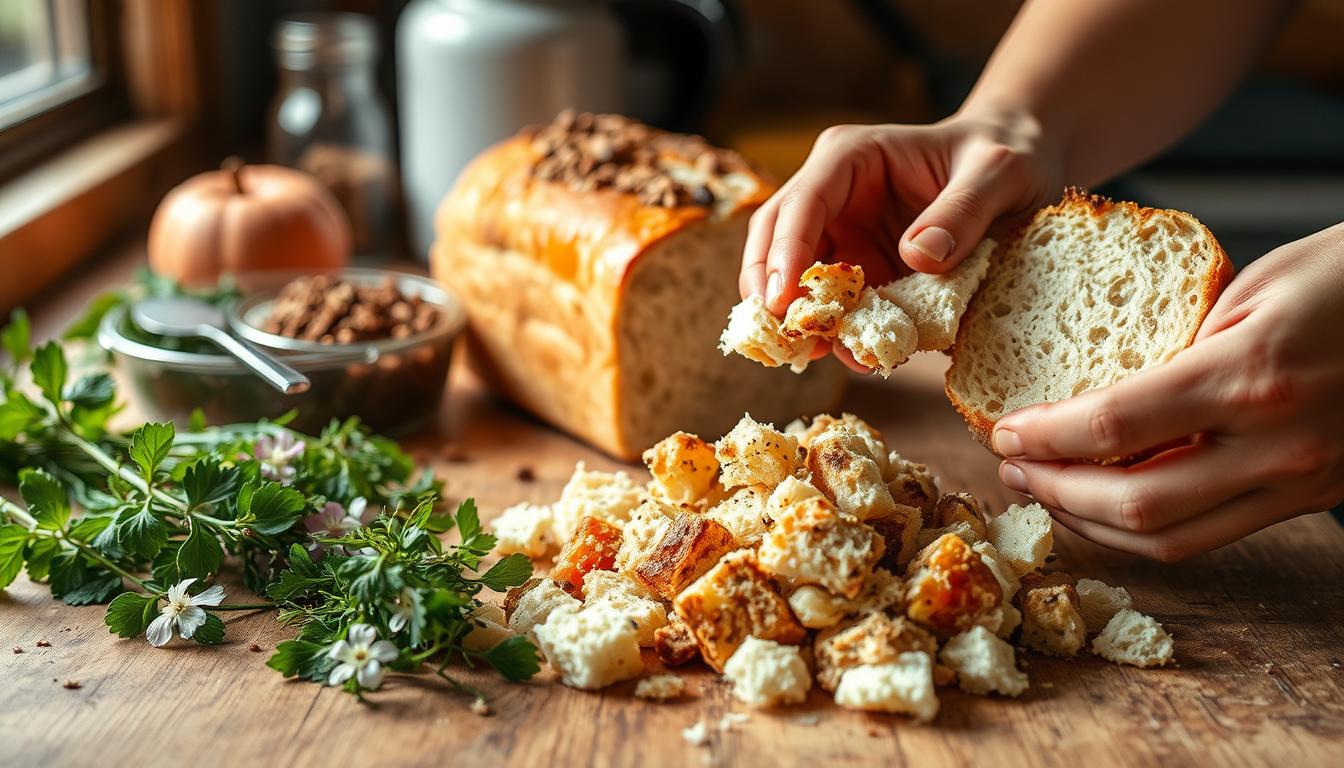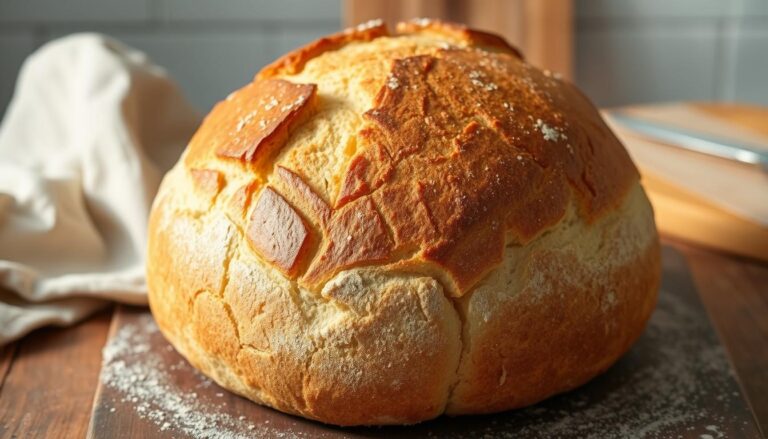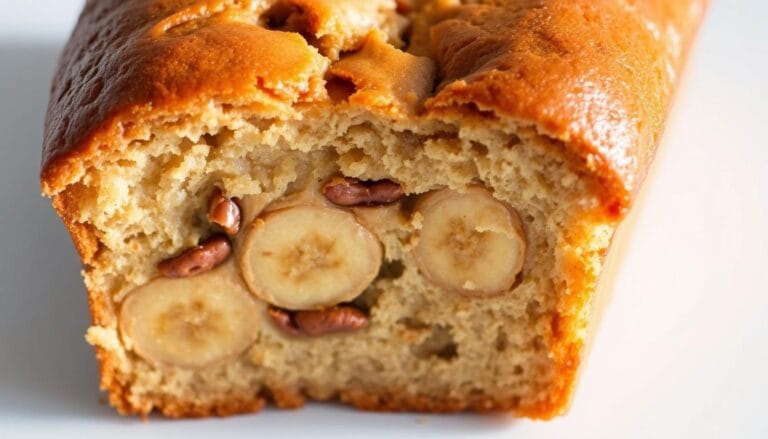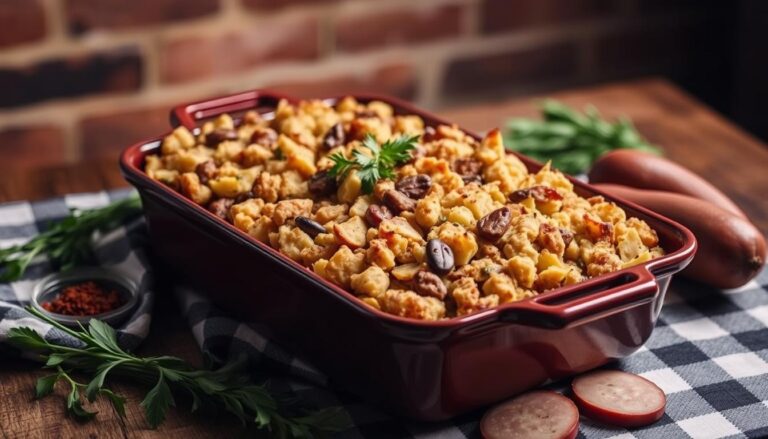Can you make stuffing with sourdough bread for perfect stuffing ?
The smell of freshly baked stuffing brings back memories of family gatherings. It’s filled with laughter and the warmth of shared meals. If you’ve ever thought about using day-old sourdough bread for stuffing, you’re in for a treat.
Sourdough bread is more than just bread. It’s a game-changer for your stuffing. Its tangy flavor and robust texture make your holiday side dish special. Wondering if you can make stuffing with sourdough bread? Yes, you can!
This guide will show you how to make a delicious sourdough stuffing. It will have your dinner guests asking for more. We’ll cover everything from picking the right loaf to preparing it perfectly.
Get ready to make your holiday meals special with a sourdough stuffing recipe. It’s a mix of tradition and a unique, flavorful twist. Your taste buds are in for a treat.
Table of Contents
The Benefits of Using Sourdough Bread in Stuffing
When making your next thanksgiving stuffing, think about using sourdough bread. This artisan bread makes your stuffing special, taking it from good to great.
Sourdough bread is a top pick for stuffing. It has qualities that make it better than regular bread. This makes your stuffing taste more complex and satisfying.
Enhanced Flavor Profile
Sourdough’s fermentation gives it a tangy, strong flavor. This flavor is unmatched by regular bread. Your stuffing will taste richer, with a deeper flavor that goes well with herbs and spices.
- Provides a subtle acidic undertone
- Enhances overall dish complexity
- Adds depth to traditional thanksgiving stuffing recipes
Superior Texture Properties
Sourdough’s dense, chewy texture keeps your stuffing just right. It doesn’t get mushy, so every bite is satisfying.
- Resists breaking down during preparation
- Creates a substantial mouthfeel
- Maintains structural integrity throughout cooking
Better Moisture Absorption
The best thing about sourdough in stuffing is how well it absorbs moisture. It takes in broths and seasonings without losing its shape. This makes your stuffing moist but not soggy.
- Absorbs liquid evenly
- Prevents dry or overly wet stuffing
- Ensures consistent texture throughout
Professional chefs agree: sourdough bread transforms ordinary stuffing into an extraordinary culinary experience.
Can You Make Stuffing with Sourdough Bread?
Yes, you can make stuffing with sourdough bread! Sourdough bread is perfect for holiday stuffing. Its tangy flavor and sturdy texture make it a great choice.
Sourdough bread has many benefits for stuffing:
- Intense, complex flavor profile
- Sturdy bread structure that holds up during cooking
- Natural ability to absorb herbs and seasonings
- Unique tanginess that elevates traditional stuffing
When making stuffing with sourdough, keep a few things in mind. The bread’s dense texture keeps it from getting mushy. Its fermentation process adds depth that white bread can’t.
| Bread Type | Flavor Intensity | Texture Stability |
|---|---|---|
| Sourdough | High | Excellent |
| White Bread | Mild | Average |
| Wheat Bread | Medium | Good |
Both professional chefs and home cooks love using sourdough for stuffing. Choosing high-quality sourdough makes your stuffing a hit at any holiday.
Preparing Sourdough Bread for Stuffing
Creating the perfect homemade stuffing starts with carefully preparing your sourdough bread. The right preparation can transform your bread stuffing from ordinary to extraordinary. It ensures a delicious addition to your holiday meal.
Proper Cutting Techniques
When preparing sourdough for a stuffing recipe, uniform cutting is crucial. Follow these guidelines to achieve the perfect bread cubes:
- Use a sharp serrated knife for clean cuts
- Cut bread into 1/2 to 3/4 inch cubes
- Aim for consistent cube sizes to ensure even cooking
- Remove any tough crusts for a softer texture
Drying Methods
Drying your sourdough bread is essential for creating the ideal stuffing texture. You have multiple options to achieve the perfect dryness:
| Drying Method | Time Required | Recommended Use |
|---|---|---|
| Air Drying | 8-12 hours | Overnight on baking sheet |
| Oven Toasting | 15-20 minutes | Low temperature (250°F) |
| Countertop Drying | 4-6 hours | Room temperature method |
Timing Considerations
Planning is key when preparing sourdough bread for your stuffing recipe. Ideally, prepare your bread cubes 1-2 days before assembling the stuffing. This allows ample time for drying and flavor development in your homemade stuffing.
- Dry bread cubes 24-48 hours before cooking
- Store dried cubes in an airtight container
- Check moisture level before final preparation
Pro tip: Slightly stale sourdough bread works best for creating a rich, flavorful bread stuffing that absorbs seasonings perfectly.
Essential Ingredients for Sourdough Stuffing
Making the perfect sourdough stuffing recipe means picking the right ingredients. These should match the tangy bread’s flavor. Your Thanksgiving stuffing will be a hit with the right mix of aromatics, herbs, and moisture.
The base of a tasty stuffing includes a few key items. They turn day-old sourdough into a dish you’ll remember:
- Fresh aromatics like onions and celery
- Fragrant herbs such as sage and thyme
- High-quality chicken or vegetable broth
- Butter or olive oil for richness
When making your sourdough stuffing, think about these key flavor boosters:
| Ingredient Category | Recommended Options | Flavor Profile |
|---|---|---|
| Herbs | Fresh sage, thyme, rosemary | Earthy and aromatic |
| Protein Additions | Chopped sausage, pancetta | Rich and savory |
| Vegetables | Mushrooms, roasted garlic | Deep umami undertones |
The secret to an unforgettable Thanksgiving stuffing lies in balancing flavors and textures.
Your sourdough bread adds a unique tanginess. It pairs well with classic herbs and rich ingredients. Don’t be afraid to try unique additions that show your taste. Aim to make a stuffing that complements your main dish while being memorable on its own.
The Perfect Bread-to-Liquid Ratio
Creating the ideal homemade stuffing is all about finding the right balance between bread and liquid. Your sourdough bread recipes need this balance to make a moist, flavorful stuffing that will wow your guests.
The secret to amazing stuffing is knowing how bread absorbs liquid. Sourdough bread is especially good for stuffing because of its unique qualities.
Broth Measurements for Perfect Consistency
When making your homemade stuffing, keep these liquid measurement tips in mind:
- For every 6 cups of cubed sourdough bread, use 1.5 to 2 cups of broth
- Adjust liquid based on bread’s moisture content
- Start with less liquid and add gradually
Moisture Balance Tips
Getting the moisture just right is key. Here’s a guide to help your bread stuffing turn out perfectly:
| Bread Type | Liquid Ratio | Texture Result |
|---|---|---|
| Dry Sourdough | 2 cups per 6 cups bread | Moist and Fluffy |
| Fresh Sourdough | 1.5 cups per 6 cups bread | Dense and Rich |
Pro tip: Add liquid slowly and mix gently to avoid making your stuffing too wet. You want it to hold together well without being soggy.
Remember, sourdough bread recipes can differ. So, trust your instincts and adjust the liquid amounts based on your bread. With a gentle touch and careful observation, you’ll make the perfect homemade stuffing every time.
Herbs and Seasonings for Maximum Flavor

Making the perfect savory stuffing starts with picking the right herbs and seasonings. Your sourdough stuffing recipe will become amazing with the right flavor boosters. These will match the bread’s special tanginess.
Fresh herbs are key to making an herb stuffing that will wow your guests. The classic trio of herbs adds a lot of flavor to your dish:
- Sage: Offers a warm, earthy taste that’s great for traditional stuffing
- Thyme: Adds a soft, slightly minty flavor
- Rosemary: Brings a strong, piney taste
When making your sourdough stuffing recipe, keep these herb tips in mind:
| Herb Type | Quantity | Best Used |
|---|---|---|
| Fresh Sage | 2-3 tablespoons, chopped | Main seasoning |
| Fresh Thyme | 1-2 tablespoons, leaves stripped | Supporting flavor |
| Fresh Rosemary | 1 tablespoon, finely chopped | Aromatic accent |
Pro tip: Always taste and adjust your seasonings. The tangy sourdough bread is a great base for bold herb mixes. Feel free to try other herbs like parsley or marjoram to make your stuffing unique.
Cooking Techniques for Crispy Top and Moist Center
Making the perfect homemade stuffing is all about precision and care. Your thanksgiving stuffing can go from ordinary to amazing with the right cooking techniques. The secret is getting a crispy outside and a moist inside, especially when using sourdough bread recipes.
To get the perfect texture in your sourdough bread stuffing, you need to manage temperature and use smart baking methods. Let’s look at how to make a stuffing that will wow your holiday guests.
Temperature Control Strategies
Temperature is key to getting the right stuffing texture. Here are some important tips:
- Preheat your oven to 375°F for the best results
- Don’t let temperatures go over 400°F to avoid burning
- Place your dish on the middle rack for even heat
Baking Time Guidelines
The baking time depends on how big your stuffing is and how moist it is. For a typical homemade stuffing:
- Bake without a cover for 25-30 minutes
- Cover with foil if the top browns too fast
- Make sure the inside reaches 165°F
Pro tip: Stick a knife into the center of your thanksgiving stuffing. If it’s hot and the bread is golden brown, your sourdough bread recipes have hit the mark!
Make-Ahead and Storage Options
Planning ahead can make your holiday stuffing better. You don’t have to rush to make it. With the right prep, you can make a tasty sourdough stuffing days early.
Preparing your stuffing early has many benefits:
- It reduces cooking stress on the big day
- Flavors get better and stronger
- It makes meal planning easier
For fridge storage, make your stuffing up to two days before. Put it in an airtight container. Use plastic wrap or a lid to keep it moist.
Freezing lets you keep your stuffing longer. Here’s how to freeze it:
- Cool the stuffing completely
- Put it in a freezer-safe dish
- Wrap it in plastic wrap and foil
- Freeze for up to one month
To serve, thaw frozen stuffing in the fridge overnight. Bake it straight from the fridge. Add 10-15 minutes to the cooking time to heat it well.
Pro tip: Always check the stuffing’s internal temperature reaches 165°F when reheating.
Creative Additions and Variations
Make your sourdough bread recipes stand out by turning traditional stuffing into a masterpiece. Artisan bread stuffing lets you add your own twist, making it truly yours. It’s a chance to show off your taste and creativity.

Try new ingredients to make your stuffing a hit. It will wow your guests and make their taste buds dance.
Vegetable Enhancements
Add some excitement to your stuffing with fresh veggies:
- Roasted butternut squash for a sweet, caramelized flavor
- Wild mushrooms for an earthy depth
- Caramelized onions to add rich, complex notes
- Crisp celery for texture and freshness
Protein-Packed Options
Boost your stuffing with protein for a satisfying bite:
- Crispy bacon bits for a smoky touch
- Spicy Italian sausage for bold flavor
- Toasted pecans or walnuts for crunch
- Diced chicken or turkey for extra heartiness
Specialty Ingredients
Discover new flavors with these unique ingredients:
- Dried cranberries for a tart sweetness
- Roasted chestnuts for a luxurious texture
- Fresh herbs like sage and thyme
- Specialty spice blends to create unexpected flavor profiles
The secret to a great stuffing is finding the right mix of flavors and textures. Let the sourdough bread be the star.
Troubleshooting Common Stuffing Issues
Making the perfect homemade stuffing can be tough, even for pros. Sourdough stuffing recipes have their own set of challenges. But, we’ve got fixes for the most common bread stuffing problems.
Solving Texture Troubles
If your sourdough stuffing is too dry, there are easy fixes. Start by adding warm broth a tablespoon at a time. Gently fold it in to spread the moisture evenly.
For stuffing that’s too soggy, try this: spread it on a baking sheet. Then, bake it in the oven for 10-15 minutes. This will crisp up the edges.
- Dry Stuffing Fix: Add warm broth gradually
- Soggy Stuffing Solution: Spread and rebake
- Texture Balance: Monitor moisture carefully
Flavor Enhancement Strategies
Want to make your bread stuffing more flavorful? Here are some tips for your sourdough stuffing recipe:
| Problem | Solution |
|---|---|
| Lack of Depth | Add fresh herbs like sage, thyme, or rosemary |
| Flat Taste | Incorporate caramelized onions or sautéed garlic |
| Weak Sourdough Flavor | Mix in a splash of white wine or chicken stock |
The secret to perfect homemade stuffing is patience and careful adjustments. Every bread stuffing is different. So, don’t hesitate to try new things and taste as you go.
Pro tip: Always taste and adjust seasonings before final baking to ensure maximum flavor!
Serving and Pairing Suggestions
Your holiday stuffing can truly shine when served with the right accompaniments. Sourdough stuffing brings a unique tangy flavor that elevates traditional Thanksgiving meals. Whether you’re preparing a classic holiday stuffing or experimenting with new culinary techniques, presentation matters.
Consider these serving suggestions for your savory stuffing:
- Serve alongside roasted turkey as a classic side dish
- Use as a delicious filling for roasted chicken breasts
- Create stuffing-topped casseroles for unexpected guests
- Prepare stuffing-filled mushroom caps as elegant appetizers
Pairing your thanksgiving stuffing with complementary dishes can transform your meal. Rich proteins like roast turkey or herb-crusted chicken work beautifully with the complex sourdough flavor profile. Roasted vegetables with herbs like rosemary and thyme can enhance the overall dining experience.
“A great stuffing isn’t just a side dish—it’s the heart of the holiday meal.”
Leftover stuffing opens up creative culinary possibilities. Transform it into crispy stuffing cakes, use as a topping for salads, or incorporate into breakfast skillets for a delightful morning meal.
Remember, the key to outstanding holiday stuffing is balancing flavors and experimenting with presentation. Your guests will appreciate the extra effort and unique approach to this classic dish.
Conclusion
Making homemade stuffing with sourdough bread turns a simple side dish into a masterpiece. You’ve learned that sourdough bread is more than a trend. It’s a game-changer for your holiday table. A sourdough stuffing recipe brings unmatched flavor and texture that will wow your guests.
Can you make stuffing with sourdough bread? Yes, you can! Sourdough’s tangy taste and sturdy texture make it stand out. By following the tips in this article, you’ll create a stuffing that’s moist, crispy, and full of flavor.
Your cooking journey doesn’t stop here. Try adding different herbs, veggies, and proteins to your sourdough stuffing. Great cooking is about being creative and confident. Now, you’re ready to make a stuffing that will be a family favorite.
Explore the possibilities of sourdough bread and let your creativity shine. Make a stuffing that shows off your unique taste and style.
FAQ
Is sourdough bread a good choice for stuffing?
Yes, sourdough bread is a great choice for stuffing. It has a tangy flavor and a chewy texture. This makes it perfect for a tasty holiday side dish.The bread absorbs moisture well without getting soggy. This ensures your stuffing stays just right.
How do I prepare sourdough bread for stuffing?
Cut the sourdough bread into cubes, about 1/2 to 3/4 inch. Dry the bread out by leaving it uncovered or toasting it low. This helps it soak up liquid better during cooking.
What herbs work best with sourdough stuffing?
Sage, thyme, and rosemary are great with sourdough bread. They enhance the bread’s flavor and add depth. Use fresh herbs for the best taste, but dried ones work too.
Can I make sourdough stuffing ahead of time?
Yes, you can make it ahead. Assemble the stuffing and refrigerate it for up to 24 hours. You can also freeze it for a month. Just make sure it heats to 165°F when reheating.
How do I prevent my sourdough stuffing from becoming too dry?
Watch the liquid-to-bread ratio closely. Use broth to moisten the bread. Cover it with foil to keep it moist while baking. If it’s too dry, add a bit more broth slowly.
Can I add extra ingredients to my sourdough stuffing?
Yes! You can add sautéed mushrooms, bacon, caramelized onions, nuts, or dried fruits. Just don’t overdo it to keep the sourdough flavor.
What’s the ideal baking temperature for sourdough stuffing?
Bake it at 350°F (175°C) for the best results. This temperature ensures a crispy top and a moist inside. Cooking time is 30-45 minutes, depending on the dish size.
How much liquid should I use for sourdough stuffing?
Use about 1/2 to 3/4 cup of broth for every 4 cups of bread. Sourdough might need a bit less liquid. Start with less and add more as needed.







